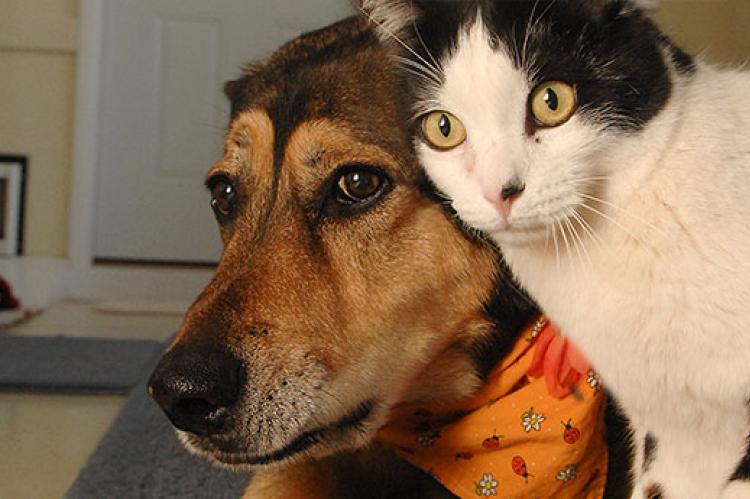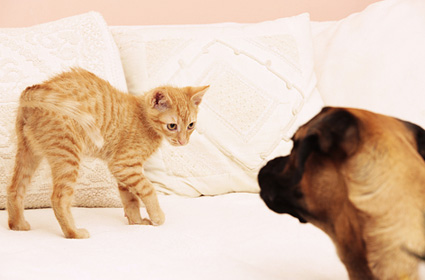Ah, cats vs. dogs, the ultimate battle! Let us say this at the very start of this discussion; both of these animals won’t react if you introduce them. Well, that is the trend anyways, and we wondered about it for a good long period. Why does it happen that claws and paws are always at daggers with each other? Our research and some simple observations revealed that most people don’t follow some basic protocols that are necessary when it comes down to introducing dogs to a cat or vice versa. So, we thought it would be a good idea to give some time and attention to this topic. Therefore, in this discussion, we are going to give away some pretty cool tricks that you can use to ensure that the first interaction between your dog and cat is a peaceful one!
Ideal locations

The first thing that you need to figure out is the meetup place, the venue, or the location where two species will interact for the first time. There are three possible scenarios. One, the cat is a resident, and the dog is a newcomer. Second, the dog is a resident, and the cat is a newcomer. Third, you just did a very crazy thing and adopted a kitty and a puppy together. Yeah, sorry, we are not going to help you with this one. But the other two, we are happy to share our wisdom with you.
If it is your canine friend who is a newcomer, you don’t have to do anything special. Just take the dog home and introduce it to the nemesis at home. However, if the situation is otherwise, then you will have to be a little cleverer. The ideal thing to do would be to introduce your dog to some other cats before bringing your baby home. This way, your canine friend will be able to interact with cats in the future, in a much-improved manner. Familiarization with cat scent is an important event in the timeline of a would-be peaceful relationship between your cat and dog. We implore you to take it a little seriously! Once the dog doesn’t have any issues with the presence of a cat in the same place, you can bring home your cat without any concerns.
Install a separation
The style has been figured out. But it would still be unwise to allow free interaction straightaway. Dogs and kittens behave most unpredictably sometimes. Hence, keeping the maximum control and authority to yourself is the wisest thing to do here. For the first week or so, it would be a wise move to keep both pets in separate places. There are two goals that you can achieve through this technique. One, you can know for sure if your pets like each other or not. Excessive barking, claw scratching, and loud meowing can give you a good clue of that! Second, you instill some behavioral modification into your pets by keeping them separate.
Should the intros be leashed?

A fundamental question and good thinking if you thought about it as well. Well, supervised interactions are a must as far as the first few days and weeks are concerned. If your observation tells you that intentions are a little hostile, putting a leash on your canine friend won’t be a bad idea. Are you biased in favor of cats? Oh, please! It just makes sense to leash the heavier of two candidates in case a fight breaks out. Putting a leash on your dog is also important if you have decided to use one room as the permanent abode for both of your pets. Ditch the leash only when things seem entirely peaceful and under control.
The value of commands
Training will be an essential feature of the first few days of this interaction between your dog and cat. It doesn’t matter who the newcomer is; both of your pets have to attend the lecture! Of course, there are more than one ways in which you can train your dog. Or cat, we do sound a bit biased here. Command-based training takes some time but eventually pays off in the longer run. Using verbal commands to ensure that your pets follow what you have in your mind is a good idea to ensure peace at home. Another improvisation that you can include in the training program is the touch of incentives. Both of our feline and canine friends love treats!
When can you breathe freely?

For how long do you need to keep doing what we have told you so far? There isn’t one specific time that we can quote to you. There are a lot of factors that can influence this whole process. Environment, interactions with other members of their species, walks, affection, and attention. Several things go into this cauldron, and only then, you can tell for sure what has been cooked. However, we do believe that the moment you see things softening up between the two species, you should relent and relax a bit. Allowing brief but unsupervised interaction, for example, is one of how you can promote canine-feline friendship. But it would help if you did not rush things. It will take some time!
Can a vet help?
Well, we are not sure about that one. We mean to say, it would be a great thing if you could get your animals checked at a vet for any underlying infectious or non-infectious diseases. But as far as the introductions go, this is something which you will have to manage on your own. Not that the vet can’t give you some good advice!
Conclusion
Well, that will be all from this discussion. We hope that you learned a lot from what we have talked about in the first feline-canine interaction. These are good tips, and trust us, if you implement them well, you will be having a great time with your pets, for sure!